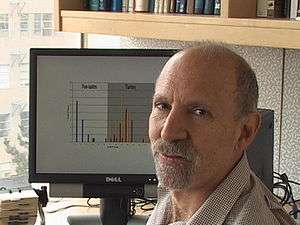Societal and cultural aspects of Tay–Sachs disease
Advances in knowledge about Tay–Sachs disease have stimulated debate about the proper scope of genetic testing, and the correctness of having diseases characterised as specific to one ethnicity. Jewish communities have been in the forefront of genetic screening and counselling for the disorder.
Impact on Jewish communities
Ashkenazi Jews have been screened as Tay–Sachs carriers since carrier testing began in 1971. Jewish communities embraced the cause of genetic screening from the 1970s on, and Israel became the first country to offer free genetic screening and counseling for Tay–Sachs disease and other diseases, leading to discussion about the proper scope of genetic testing.[1]
Much awareness of Ashkenazi Jews as an ethnic group stems from genetic studies of disease. Some regard these studies as exhibiting ascertainment bias[2] which created an impression that Jews are more susceptible to genetic disease than other populations.[2][3] They cite BRCA1 and BRCA2 mutations becoming identified as "Jewish mutations," despite there being mutations at these loci that are found in all populations. Sheila Rothman and Sherry Brandt-Rauf write: "Our findings cast doubt on the accuracy and desirability of linking ethnic groups to genetic disease. Such linkages exaggerate genetic differences among ethnic groups and lead to unequal access to testing and therapy."[3]
Controversy over heterozygote advantage

Genetic and historical studies of the Ashkenazi population suggest it may have gone through population bottlenecks, thereby giving strong support to the founder effects theory.[4][5][6][7][8] Because Tay–Sachs disease was one of the first autosomal recessive genetic disorders for which there was a test, it was intensely studied as a model for all such diseases, and researchers sought evidence of a selective process through a selective advantage for heterozygotes (carriers). Neil Risch writes: "The anomalous presence of four different lysosomal storage disorders in the Ashkenazi Jewish population has been the source of long-standing controversy. Many have argued that the low likelihood of four such diseases — particularly when four are involved in the storage of glycosphingolipids — must reflect past selective advantage for heterozygous carriers of these conditions."[4] Risch, an eminent statistical geneticist, believes the weight of evidence supports genetic drift, not a selective process.[4]
Gregory Cochran proposes that the mutant alleles causing Tay–Sachs confer higher intelligence when present in carrier form, and provided a selective advantage in the historical period when Jews were restricted to intellectual occupations.[9][10]
References
- Sagi, M (1998). "Ethical aspects of genetic screening in Israel". Science in Context. 11 (3–4): 419–429. doi:10.1017/s0269889700003112. PMID 15168671.
- Carmeli, Daphna Birenbaum (2004-08-04). "Prevalence of Jews as subjects in genetic research: Figures, explanation, and potential implications". American Journal of Medical Genetics. 130A (1): 76–83. doi:10.1002/ajmg.a.20291. PMID 15368499.
- Brandt-Rauf SI, Raveis VH, Drummond NF, Conte JA, Rothman SM (November 2006). "Ashkenazi Jews and Breast Cancer: The Consequences of Linking Ethnic Identity to Genetic Disease". American Journal of Public Health. 96 (11): 1979–1988. doi:10.2105/AJPH.2005.083014. PMC 1751808. PMID 17018815.
- Risch N, Tang H, Katzenstein H, Ekstein J (2003). "Geographic Distribution of Disease Mutations in the Ashkenazi Jewish Population Supports Genetic Drift over Selection". American Journal of Human Genetics. 72 (4): 812–822. doi:10.1086/373882. PMC 1180346. PMID 12612865.
- Frisch A, Colombo R, Michaelovsky E, Karpati M, Goldman B, Peleg L (2004). "Origin and spread of the 1278insTATC mutation causing Tay–Sachs disease in Ashkenazi Jews: genetic drift as a robust and parsimonious hypothesis". Human Genetics. 114 (4): 366–76. doi:10.1007/s00439-003-1072-8. PMID 14727180.
- Slatkin, M (2004). "A Population-Genetic Test of Founder Effects and Implications for Ashkenazi Jewish Diseases". American Journal of Human Genetics. 75 (2): 282–293. doi:10.1086/423146. PMC 1216062. PMID 15208782.
- Crow, James F. (2008). "Mid-Century Controversies in Population Genetics". Annual Review of Genetics. 42: 1–16. doi:10.1146/annurev.genet.42.110807.091612. PMID 18652542.
- Crow, James F. (1997). "Motoo Kimura, 13 November 1924 - 13 November 1994". Biographical Memoirs of Fellows of the Royal Society. 43: 254–265. doi:10.1098/rsbm.1997.0014.
- Cochran, Gregory; Harpending, Henry (2009). "Medieval Evolution: How the Ashkenazi Jews Got Their Smarts". The 10,000 Year Explosion. New York: Basic Books.
- Wade, Nicholas (2005-06-03). "Researchers Say Intelligence and Diseases May Be Linked in Ashkenazic Genes". New York Times. Retrieved 2009-05-27.